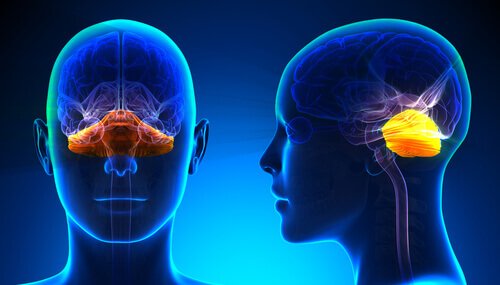Ataxia: Symptoms, Causes, and Treatment

Many things can influence our health and, therefore, our quality of life. Our movement can also be affected. In fact, there’s a very characteristic clinical sign named ataxia that’s characterized by coordination, posture, and voluntary control issues.
This clinical sign consists of a lack of muscular control to perform movements. It can manifest for various reasons. In this article, we discuss its causes, diagnosis, and treatment.
What is ataxia?
The word ataxia comes from ancient Greek and means “without order”. It’s an alteration of the coordination of all types of movements in the absence of paralysis. Ataxia can affect gait, torso, limbs, or any combination of these. In addition, it can be evidenced in the following symptoms:
- Nystagmus: Involuntary, uncontrollable eye movements.
- Dysarthria: Difficulty articulating sounds and words.
- Hypotonia: Decreased tension or muscle tone.
- Dysmetria: Condition that keeps the individual from performing motor actions that adjust to the distance demanded.
- Dysdiadochokinesia: Impaired ability to quickly make alternating movements.
- Dysphagia: Difficulty swallowing.
- Difficulty walking or even total loss of the ability to walk.
- Lack of coordination and precision.
- Cognitive alterations (in regards to thought processes).
- Emotional alterations: It causes emotional instability because it’s a very taxing condition.
Ataxia can manifest with another disease, such as multiple sclerosis. However, it can also manifest on its own, although this rarely ever happens. Both children and adults can suffer from ataxia. In fact, Salman and others (2013) carried out a study where they analyzed the epidemiology of chronic ataxia in children. Said study was published in the journal Developmental Medicine and Child Neurology.

What causes ataxia?
Acquired ataxia: Manifests due to another pathology the patient suffers.
- Toxic: For example, due to carbon monoxide or alcoholic cerebellar degeneration.
- Autoimmune: Such as ataxia caused by gluten and the one related to paraneoplastic subacute cerebellar degeneration.
- Nutritional deficit: Such as vitamin E deficiency, Wernicke-Korsakoff syndrome, and subacute combined degeneration.
- Neurodegenerative diseases: Such as multiple sclerosis and spinocerebellar ataxia.
- Tumors: Tumors such as medulloblastoma, astrocytoma, and hemangioblastoma can cause ataxia.
Genetic ataxia: They’re inherited and can be autosomal recessive or dominant.
- Recessive: Friedreich’s ataxia is the most common one. It’s caused by neurodegeneration in the ganglion cells of the dorsal root, the spinocerebellar and corticospinal tracts, and the dentate nucleus.
- Dominant: Depending on the course of the disease, they can be episodic or progressive. Within the dominant ataxias, we find spinocerebellar ataxias, congenital cerebellar ataxia, and cerebellar vermis aplasia, among others.
As you can see, there are different types of ataxias. As of now, there is no cure for this condition. However, there are treatments that can help patients who suffer from it.
Diagnosing ataxia
There are different tests that can diagnose ataxia:
- Finger-nose: The patient is asked to touch their nose with the tip of their index finger. Then, they’re asked to touch the doctor’s index finger.
- Heel-knee: The patient must be in supine decubitus position. The examiner asks them to place their heel on the knee of their other leg and then make it slide down their tibial crest. The patient carries this out with their eyes open and closed and with both extremities.
- Fast alternating exercises: The doctor asks the patient to rotate both hands simultaneously both ways.
- Electromyogram: It’s a nerve conduction study.
- Psychodiagnosis: Neuropsychological studies that evaluate the patient’s executive functions.

Treatments for ataxia
The treatments for this condition are limited and not specific to the disease. The treatments tend to be more aimed at rehabilitation.
In addition, psychological intervention is important. First off, they help the patient understand what’s happening to them. Secondly, they also help them learn to manage the emotions and thoughts about their condition. Last but certainly not least, the patient’s caregivers must also participate in this psychological intervention so that they can learn how to care for them.
Many things can influence our health and, therefore, our quality of life. Our movement can also be affected. In fact, there’s a very characteristic clinical sign named ataxia that’s characterized by coordination, posture, and voluntary control issues.
This clinical sign consists of a lack of muscular control to perform movements. It can manifest for various reasons. In this article, we discuss its causes, diagnosis, and treatment.
What is ataxia?
The word ataxia comes from ancient Greek and means “without order”. It’s an alteration of the coordination of all types of movements in the absence of paralysis. Ataxia can affect gait, torso, limbs, or any combination of these. In addition, it can be evidenced in the following symptoms:
- Nystagmus: Involuntary, uncontrollable eye movements.
- Dysarthria: Difficulty articulating sounds and words.
- Hypotonia: Decreased tension or muscle tone.
- Dysmetria: Condition that keeps the individual from performing motor actions that adjust to the distance demanded.
- Dysdiadochokinesia: Impaired ability to quickly make alternating movements.
- Dysphagia: Difficulty swallowing.
- Difficulty walking or even total loss of the ability to walk.
- Lack of coordination and precision.
- Cognitive alterations (in regards to thought processes).
- Emotional alterations: It causes emotional instability because it’s a very taxing condition.
Ataxia can manifest with another disease, such as multiple sclerosis. However, it can also manifest on its own, although this rarely ever happens. Both children and adults can suffer from ataxia. In fact, Salman and others (2013) carried out a study where they analyzed the epidemiology of chronic ataxia in children. Said study was published in the journal Developmental Medicine and Child Neurology.

What causes ataxia?
Acquired ataxia: Manifests due to another pathology the patient suffers.
- Toxic: For example, due to carbon monoxide or alcoholic cerebellar degeneration.
- Autoimmune: Such as ataxia caused by gluten and the one related to paraneoplastic subacute cerebellar degeneration.
- Nutritional deficit: Such as vitamin E deficiency, Wernicke-Korsakoff syndrome, and subacute combined degeneration.
- Neurodegenerative diseases: Such as multiple sclerosis and spinocerebellar ataxia.
- Tumors: Tumors such as medulloblastoma, astrocytoma, and hemangioblastoma can cause ataxia.
Genetic ataxia: They’re inherited and can be autosomal recessive or dominant.
- Recessive: Friedreich’s ataxia is the most common one. It’s caused by neurodegeneration in the ganglion cells of the dorsal root, the spinocerebellar and corticospinal tracts, and the dentate nucleus.
- Dominant: Depending on the course of the disease, they can be episodic or progressive. Within the dominant ataxias, we find spinocerebellar ataxias, congenital cerebellar ataxia, and cerebellar vermis aplasia, among others.
As you can see, there are different types of ataxias. As of now, there is no cure for this condition. However, there are treatments that can help patients who suffer from it.
Diagnosing ataxia
There are different tests that can diagnose ataxia:
- Finger-nose: The patient is asked to touch their nose with the tip of their index finger. Then, they’re asked to touch the doctor’s index finger.
- Heel-knee: The patient must be in supine decubitus position. The examiner asks them to place their heel on the knee of their other leg and then make it slide down their tibial crest. The patient carries this out with their eyes open and closed and with both extremities.
- Fast alternating exercises: The doctor asks the patient to rotate both hands simultaneously both ways.
- Electromyogram: It’s a nerve conduction study.
- Psychodiagnosis: Neuropsychological studies that evaluate the patient’s executive functions.

Treatments for ataxia
The treatments for this condition are limited and not specific to the disease. The treatments tend to be more aimed at rehabilitation.
In addition, psychological intervention is important. First off, they help the patient understand what’s happening to them. Secondly, they also help them learn to manage the emotions and thoughts about their condition. Last but certainly not least, the patient’s caregivers must also participate in this psychological intervention so that they can learn how to care for them.
All cited sources were thoroughly reviewed by our team to ensure their quality, reliability, currency, and validity. The bibliography of this article was considered reliable and of academic or scientific accuracy.
- Marquer, A., Barbieri, G. & Pérennou, D. (2014). The assessment and treatment of postural disorders in cerebellar ataxia: a systematic review. Annals of physical and rehabilitation medicine, 57 (2), pp. 67-78.
- Navarro, H. A., Hernández, J.A.B., Piudo, R.L., & Jiménez, F.J.J. (2007). Síndromes atáxicos. Ataxias heredodegenerativas y adquiridas. Medicine: Programa de Formación Médica Continuada, 9 (74), pp. 4764-4775.
- Ruggieri, V. L & Arberas, C.L. (2000). Ataxias hereditarias. Revista de neurología, 32 (3), pp. 288-296.
- Salman, M. S. (2017). Epidemiology of cerebellar diseases and therapeutc approaches. The Cerebellum, pp. 1-8.
This text is provided for informational purposes only and does not replace consultation with a professional. If in doubt, consult your specialist.







